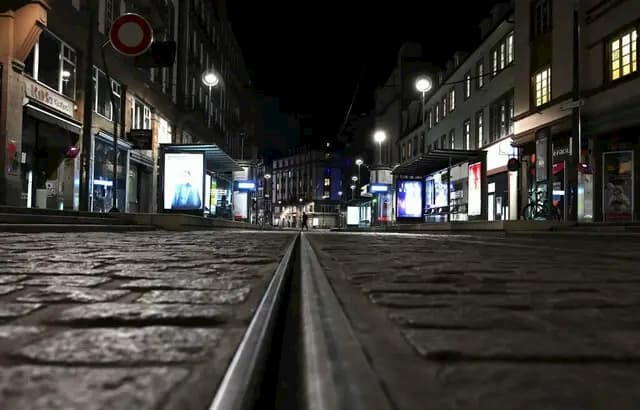Coronavirus: “For the Moment, the Curfew at 6 pm has No Obvious Effect”

CURFEW: For the creator of the CovidTracker data site, Guillaume Rozier, it is still too early to say if the curfew starting at 6 pm has had any effect
- The government could announce this Thursday evening a further widening of the curfew at 6 pm to new departments, or even to the whole of France.
- In the departments concerned since January 2 by this measure, we note a slight tremor, but it is still impossible to say whether or not it is linked to the advanced curfew, says the engineer who created the CovidTracker site Guillaume Rozier.
- Without stricter confinement, it is likely that going below a certain contamination threshold will be impossible.
Will you resume a little more curfew? Say at 6 o’clock? Applied since January 2nd in 15 departments, and since January 8th and 12th in 10 more, the government could announce this Thursday evening a new territorial expansion of this measure, which aims to slow down contamination with the coronavirus. And why not in the whole of France?
But does the measure work? Yes, for the Minister of Health, Olivier Véran, who indicates that the percentage increase in the incidence rate is lower in the departments affected by the reinforced curfew than elsewhere. Not so fast, responds in a way Guillaume Rozier, the data analyst engineer who created the CovidTracker site, which processes official data on the pandemic in France. 20 Minutes questioned him.
The 6 pm curfew has already been in effect in part of the country since January 2nd. On the data you are using, are you already seeing an effect, or is it too early?
For the moment, we do not see any obvious effect. When we group together all the departments put on curfew at 6 pm on January 2nd, we notice that the cases continue to increase. But, in proportion, the number of cases increases a little less sharply than elsewhere in France. In all the departments, the number of cases increased by about 20% compared to January 2nd, and it is rather 15% in the departments affected by the earlier curfew.
Is it significant?
At the moment, that doesn’t mean much for several reasons. First, because in absolute terms, growth is always higher there than elsewhere. However, since they already had a higher number of cases, the percentage increase was lower. Then this slowdown started a little before January 2nd. This could be the effect of a change in people’s behaviour not necessarily directly related to curfew starting earlier.
Finally, it is a little early to know the effects of the measure: the data from Public Health France of January 13th reflects the situation of January 10th. As we take a moving average over seven days, in order to erase the effects of weekends, the last really analyzable data are those of January 7. It would be necessary to have at least the data of January 10th, even of January 12th, to have a little serious conclusion.
When the second confinement came into effect, the first effects were felt ten days later. And after a possible stabilization, we must wait to see if there is indeed a decline. At this time, I do not see what allows us to say that the relative deceleration that we observe is an effect of the reinforced curfew.
As long as there is not more strict confinement, can we not reach a lower level of contamination?
This is exactly what we observed in December: we reached a plateau. And again, it was the effect of the second confinement. The confinement as we knew it in November and early December, then the passage to the curfew, did not allow us to go below a certain level of contamination. It was probably a “cruising level”, inevitable contaminations in the supermarket, during the few contacts allowed, which cannot be reduced unless confined more harshly.
This fall, with lighter confinement, we were still pleasantly surprised by the results at the start, with a very clear and very rapid drop in cases. People have really adapted their individual behaviour, as can be seen, for example, with Google data on mobility or with crowds in transport, from mid-October. It can also be seen in Coviprev, the study by Public Health France which asks people if they respect barrier gestures. We saw a real change from mid-October when the first curfew was put in place, and the change is national.
You also follow contaminations by age. There is a lot of talk about the fact that one of the variants of the virus may be more contagious in children. Can we already see it through the data?
Yes. In France, the positivity of tests (the proportion of positive tests) is quite high among 0-19-year-olds but especially among 0-9-year-olds. It’s even the highest positivity rate of any age group right now. It is almost 10% while it is around 6-7% for the other classes.
In recent months, we have never observed a higher positivity rate among 0-9-year-olds than elsewhere. It is true that this is an age group that is tested much less, but the share of 0-9-year-olds among people who are tested has not changed: this higher positivity rate is not the fact of a decrease in the number of tests. The number of tests carried out has been rather stable since January 1st. We cannot say that the virus circulates more than elsewhere (because we do not test enough the 0-9 years), but this rate of positivity which increases more than elsewhere in this age group is surprising. In any case, I do not explain it yet.
Enjoyed this? Get the week’s top France stories
One email every Sunday. Unsubscribe anytime.


